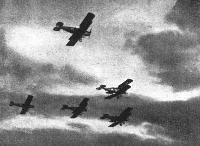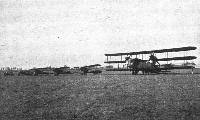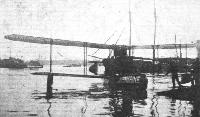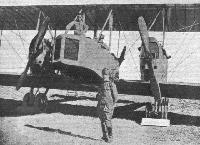Фотографии
-
Two of the starboard 150 h.p. Sunbeam engines on the Sikorsky biplane
Самолёты на фотографии: Сикорский Илья Муромец - Россия - 1913
-
Sir Ross Smith leaving Richmond, N.S.W., on his Vickers-Vimy-Rolls.
Самолёты на фотографии: Vickers Vimy / FB.27 - Великобритания - 1917
-
Регистрационный номер: G-EAOU Sir Ross Smith at Richmond, N.S.W., getting ready
Самолёты на фотографии: Vickers Vimy / FB.27 - Великобритания - 1917
-
THE OPENING OF WADDON AIR PORT: After serving as the London Terminus for continental air traffic for several months, Hounslow aerodrome has been relinquished for the use of Cavalry, and the port arrangements have been transferred to Waddon, near Croydon, from which air port traffic was inaugurated on Monday of this week. Our photo show the Farman Goliath ready for the trip to Paris.
Самолёты на фотографии: Farman F.60 Goliath / F.169 - Франция - 1918
-
A flight of Bristols in the clouds
Самолёты на фотографии: Bristol F.2A/F.2B Fighter - Великобритания - 1916
-
The Bristol "family" at Home. Left to right: The Bristol Babe, the Bristol monoplane, the Bristol Badger, the Bristol Fighter, the Bristol Tourer and the Bristol Pullman triplane
Самолёты на фотографии: Bristol Babe - Великобритания - 1919Bristol Braemar / Pullman - Великобритания - 1918Bristol F.2A/F.2B Fighter - Великобритания - 1916Bristol F.2C / Badger - Великобритания - 1919Bristol M.1A / M.1B / M.1C - Великобритания - 1916Bristol Tourer - Великобритания - 1919
-
CUMULUS CLOUD FORMING IN HOT WEATHER: A Vickers-Vimy commercial type aeroplane flying above the clouds.
Самолёты на фотографии: Vickers Vimy Commercial - Великобритания - 1919
-
The line-up for the cross-country race at Bournemouth on Easter Monday. From left to right the machines are Caudron G.3 (70 h.p. Renault), F.E.2b (160 h.p. Beardmore), De H.6 (80 h.p. Renault), Avro (110 h.p. Le Rhone), Avro (110 h.p. Le Rhone), Avro (110 h.p. Le Rhone). The course was a double-circuit from the Bournemouth Aerodrome, round Christchurch Priory, a distance of 20 miles.
Самолёты на фотографии: Avro Avro 504 - Великобритания - 1913Caudron G.3 - Франция - 1913De Havilland D.H.6 - Великобритания - 1917RAF F.E.2 - Великобритания - 1914
-
A BREEZY LANDING: An Eastbourne Aviation Co.'s Avro waterplane making for the shore off Brighton.
Самолёты на фотографии: Avro Avro 504 - Великобритания - 1913
-
Made in Germany: A correspondent sends us this photograph of a German Fokker biplane which was flown by a Canadian pilot at Shoreham during May of last year
Самолёты на фотографии: Fokker D.VII - Германия - 1917
-
When at a height of about 6,000 ft. the upper plane broke away from the machine, leaving the centre section struts and N struts on the fuselage and lower wing respectively. Needless to say the unfortunate pilot was killed
Самолёты на фотографии: Fokker D.VII - Германия - 1917
-
Front view of the Junker D 1 monoplane
Самолёты на фотографии: Junkers D.I / J 9 - Германия - 1918
-
Three-quarter rear view of the Junker D1 monoplane
Самолёты на фотографии: Junkers D.I / J 9 - Германия - 1918
-
Three-quarter rear view of a damaged Junker D 1 monoplane
Самолёты на фотографии: Junkers D.I / J 9 - Германия - 1918
-
Front view of a damaged Junker D 1 monoplane
Самолёты на фотографии: Junkers D.I / J 9 - Германия - 1918
-
JUNKER ALL-METAL MONOPLANE. TYPE D.I. 180 HP MERCEDES
Самолёты на фотографии: Junkers D.I / J 9 - Германия - 1918
-
One of the Supermarine four-seater "Channel" flying boats, the type which was tested by Gen. Sykes during his visit to the Supermarine works at Southampton last week
Самолёты на фотографии: A.D. Flying Boat - Великобритания - 1916
-
At the New York Aero Show: The Curtiss "Oriole" three-seater biplane
Самолёты на фотографии: Curtiss Oriole / Type 17 - США - 1919
-
THE MONACO SEAPLANE MEETING: The Nieuport seaplane on the North quay, having its engines tested.
Самолёты на фотографии: Nieuport Nieuport-29 - Франция - 1918
-
Three-quarter rear view of the American-built Caproni biplane
Самолёты на фотографии: Caproni Ca.1 - Ca.3, Ca.5 - Италия - 1914
-
A close-up view of the mid-wing portion of the American-built Caproni biplane
Самолёты на фотографии: Caproni Ca.1 - Ca.3, Ca.5 - Италия - 1914
-
Front view of the American-built Caproni biplane
Самолёты на фотографии: Caproni Ca.1 - Ca.3, Ca.5 - Италия - 1914
-
The American-built Caproni biplane in flight
Самолёты на фотографии: Caproni Ca.1 - Ca.3, Ca.5 - Италия - 1914
-
Side view of the American-built Caproni biplane
Самолёты на фотографии: Caproni Ca.1 - Ca.3, Ca.5 - Италия - 1914
-
An Italian prototype Caproni, which differs from the American types in minor details only
Самолёты на фотографии: Caproni Ca.1 - Ca.3, Ca.5 - Италия - 1914
-
American Caproni biplane. 3,330 HP Liberty engines.
Самолёты на фотографии: Caproni Ca.1 - Ca.3, Ca.5 - Италия - 1914
-
Three-quarter front, view of the "Orenco" Type "D" pursuit single-seater fighter
Самолёты на фотографии: Orenco D - США - 1919
-
Orenco Type D-2 Pursuit Fighter 300 h.p. Hispano-Suiza Engine
Самолёты на фотографии: Orenco D - США - 1919
-
Orenco Type D Pursuit Fighter 300 h.p. Hispano-Suiza Engine
Самолёты на фотографии: Orenco D - США - 1919
-
At the New York Aero Show: The Horace Kean "Ace" K-1 Sport Plane.
Самолёты на фотографии: Aircraft Engineering (AEC) Ace - США - 1919
-
AT THE NEW YORK AERO SHOW: The L.W.F.-Cato "Butterfly " Sporting monoplane.
Самолёты на фотографии: LWF Butterfly / L - США - 1920
-
Регистрационный номер: G-EAEQ [2] Getting ready at Bombay for the flight to Poona.
Самолёты на фотографии: Nieuport & General Nighthawk - Великобритания - 1918
-
Регистрационный номер: G-EAEQ [2] The arrival of the newspapers at Poona.
Самолёты на фотографии: Nieuport & General Nighthawk - Великобритания - 1918
-
A Nieuport "NIGHTHAWK" in India. During the later part of last year the British Nieuport Co. sent a Mission out to India, where some excellent propaganda work was done. The Mission was under the leadership of Capt. R. S. Carroll, who had with him Lieut. J. H. James, one of the Nieuport test pilots. On arriving in Bombay the "Nighthawk" was uncrated and erected in record time, and was soon to be seen flying over Bombay. While in India a great number of flights were made, among others one from Bombay to Poona with a load of newspapers. Photograph show: The machine just after arrival at Poona. On the left is Lieut. James, and on the right Capt. Carroll. The Nieuport caused great interest throughout the districts visited, and its handling was much admired. During the next few years India should offer a good field for commercial aviation, and Major Heckstall Smith is to be congratulated on his enterprise in introducing the Nieuport machine to the residents of India.
Самолёты на фотографии: Nieuport & General Nighthawk - Великобритания - 1918
-
Side view of the Thomas-Morse twin-engine, twin-fuselage biplane
Самолёты на фотографии: Thomas-Morse MB-4 - США - 1920
-
Side view of the "Orenco" Type "B" pursuit single-seater fighter
Самолёты на фотографии: Orenco B - США - 1917
-
Orenco Type B Pursuit Fighter 160 h.p. Gnome Engine
Самолёты на фотографии: Orenco B - США - 1917
-
Orenco Type C-2 Pursuit Training Plane 80 h.p. le Rhone Engine
Самолёты на фотографии: Orenco B - США - 1917
-
Orenco Type C-4 Cross-country 2-Seater 80 h.p. le Rhone Engine
Самолёты на фотографии: Orenco B - США - 1917
-
Orenco Type H-2 Coast Artillery & Observation Plane Two 300 h.p. Hispano-Suiza Engines
Самолёты на фотографии: Orenco B - США - 1917
-
Orenco Type I 4-Seater Sport Boat 150 h.p. Hispano-Suiza Engine
Самолёты на фотографии: Orenco B - США - 1917
-
At the New York Aero Show: The "Orenco" model F. 4-seater "Tourist."
Самолёты на фотографии: Orenco F Tourister - США - 1920
-
The "Orenco" Type "F" four-seater "commercial" biplane
Самолёты на фотографии: Orenco F Tourister - США - 1920
-
Orenco Type F 4-Seater Touring or Mail Plane 150 h.p. Hispano-Suiza Engine
Самолёты на фотографии: Orenco F Tourister - США - 1920
-
At the New York Aero Show: The Dayton-Wright O-W Aerial Sedan.
Самолёты на фотографии: Dayton-Wright OW-1 Aerial Coupe - США - 1919
-
At the New York Aero Show: The Dayton-Wright K-T Cabin Cruiser.
Самолёты на фотографии: Dayton-Wright KT Cabin Cruiser - США - 1920
-
THE MONACO SEAPLANE MEETING: At Monaco: Two French flying boats. That nearest the camera is the Tellier-Hispano of the Toulon squadron, which was to make the Monaco-Tunis-Monaco hors de concours. The other machine is the Sunbeam-engined Tellier-Nieuport flying boat which M. Sadl Lecointe entered to fly in the Monaco-Tunis-Monaco flight.
Самолёты на фотографии: Tellier Tellier-200 - Франция - 1916
-
THE MONACO SEAPLANE MEETING: The Sunbeam engine fitted in the Tellier-Nieuport.
Самолёты на фотографии: Tellier Tellier-200 - Франция - 1916
-
THE MONACO SEAPLANE MEETING: A view of the Sunbeam-engined Tellier-Nieuport flying boat at her moorings
Самолёты на фотографии: Tellier Tellier-200 - Франция - 1916
-
AT MONACO: The Spad getting ready for a flight. Inset, the machine, piloted by Casale, off for an altitude flight. Note the long single-step floats.
Самолёты на фотографии: Bleriot-SPAD S.26 - Франция - 1919
-
At the New York Aero Show: The Curtiss "Seagull" flying boat
Самолёты на фотографии: Curtiss MF - США - 1918
Статьи
- Flight


















































